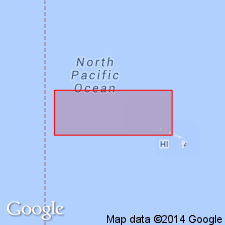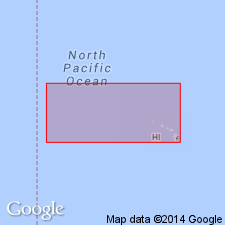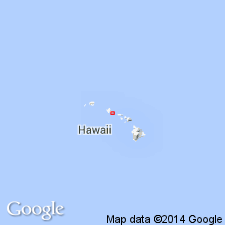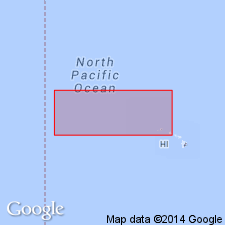
- Usage in publication:
-
- Salt Lake tuff
- Modifications:
-
- Named
- Dominant lithology:
-
- Tuff
- AAPG geologic province:
-
- Oahu
Summary:
Named for Salt Lake Crater east of Pearl Harbor, [Puuloa 7.5' quad] Island of Oahu. Formerly Upper Salt Lake tuff of Wentworth (1926). [Lower Salt Lake tuff replaced by Aliamanu tuff (new)]. Included in middle part of Honolulu volcanic series. Not differentiated in field from Makalapa tuff (new). Consists of subaerial gray to brown tuff containing nodules of dunite. Is as much as 300 ft thick. Contains upright tree molds and passes beneath sea level. Overlies Aliamanu tuff (new). Unconformably overlies eroded and dissected gravels of Kaena terraces which indicate it was laid down during Waipio stand of sea. Assigned middle(?) and late Pleistocene age.
Source: GNU records (USGS DDS-6; Menlo GNULEX).

- Usage in publication:
-
- Salt Lake tuff*
- Modifications:
-
- Age modified
- AAPG geologic province:
-
- Oahu
Summary:
Contains upright vegetation molds and fossilized remains of trees including koa (ACACIA KOA Gray), loulu palm (EUPRITCHARDIA sp.) and ohia (METROSIDEROS COLLINA). Fossils indicate greater rainfall than at present suggesting they grew during stage of lowered sea level and increased rainfall at low altitudes accompanying Pleistocene glaciation. Assigned late Pleistocene age.
Source: GNU records (USGS DDS-6; Menlo GNULEX).

- Usage in publication:
-
- Salt Lake Tuff*
- Modifications:
-
- Geochronologic dating
- AAPG geologic province:
-
- Oahu
Summary:
K-Ar ages on nepheline-melilite from Salt Lake lava [tuff] range from 446 +/-21 to 418 +/-18 Ka.
Source: GNU records (USGS DDS-6; Menlo GNULEX).

- Usage in publication:
-
- Salt Lake Tuff*
- Modifications:
-
- Geochronologic dating
- AAPG geologic province:
-
- Oahu
Summary:
Th-U ages on 4 samples of calcareous sandstone near Kailua, Nanakuli, Kahuku, and Haleiwa gave ages of respectively 110 +/-20, 120 +/-30, 110 +/-20, and 140 +/-30 ka (Vech, 1966 p.3353). "The calcareous sandstone capping Salt Lake Tuff is correlated with the Waimanalo stand of the sea. Thus the date for the youngest eruptions from Salt Lake crater predates 90,000 to 170,000 years B.P."
Source: GNU records (USGS DDS-6; Menlo GNULEX).

- Usage in publication:
-
- Salt Lake Tuff†
- Modifications:
-
- Abandoned
- AAPG geologic province:
-
- Oahu
Summary:
Salt Lake Tuff (Stearns, IN Stearns and Vaksvik, 1935) abandoned as formally named unit and renamed Salt Lake tuff cone, informal unit of Honolulu Volcanics.
Source: GNU records (USGS DDS-6; Menlo GNULEX).
For more information, please contact Nancy Stamm, Geologic Names Committee Secretary.
Asterisk (*) indicates published by U.S. Geological Survey authors.
"No current usage" (†) implies that a name has been abandoned or has fallen into disuse. Former usage and, if known, replacement name given in parentheses ( ).
Slash (/) indicates name conflicts with nomenclatural guidelines (CSN, 1933; ACSN, 1961, 1970; NACSN, 1983, 2005, 2021). May be explained within brackets ([ ]).

